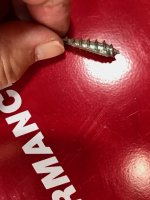I was testing my saws capabilities on some really thick walnut full depth and I crosscut a screw. I thought something blew on the saw but I was able to realign and finish the cut
Any concerns? Anything to check? Thanks
Sent from my iPhone using Tapatalk
Any concerns? Anything to check? Thanks
Sent from my iPhone using Tapatalk


